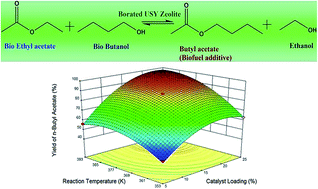Process optimization by response surface methodology for transesterification of renewable ethyl acetate to butyl acetate biofuel additive over borated USY zeolite†
Abstract
Butyl acetate, a renewable biofuel additive was synthesized by transesterification of butanol with ethyl acetate via a renewable and sustainable route. Use of fermentation derived bio-butanol and bio-ethyl acetate for synthesis of butyl acetate would be a more advantageous route over conventional Fischer Esterification. For the first time, a heterogeneous zeolite catalyst such as Ultra Stable Y (USY) and its modified versions obtained by borating on parent USY were used for the synthesis of butyl acetate. Response surface methodology (RSM) was employed to optimize the process parameters for transesterification of butanol with ethyl acetate over a 4% (w/w) B–USY catalyst. The influence of three crucial process variables such as catalyst loading, molar ratio, and reaction temperature on yield of butyl acetate were addressed by Box–Behnken experimental design (BBD). 4% (w/w) B–USY was proved to be a potential catalyst with 96% yield of butyl acetate at optimum process parameters. The 4% (w/w) B–USY catalyst was found to be reusable for 6 catalytic cycles.


 Please wait while we load your content...
Please wait while we load your content...